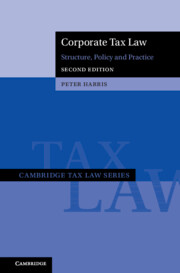Book contents
- Corporate Tax Law
- Cambridge Tax Law Series
- Corporate Tax Law
- Copyright page
- Contents
- Preface
- Abbreviations
- Introduction
- 1 Taxation of Corporate Income When Derived
- 2 Taxation of Corporate Income When Distributed
- 3 Taxation of Corporate Income
- 4 Creating Share Interests
- 5 Transferring Share Interests
- 6 Terminating Share Interests
- 7 Varying Share Interests
- 8 Dividend and Capital Stripping and Value Shifting
- References
1 - Taxation of Corporate Income When Derived
Published online by Cambridge University Press: 29 February 2024
- Corporate Tax Law
- Cambridge Tax Law Series
- Corporate Tax Law
- Copyright page
- Contents
- Preface
- Abbreviations
- Introduction
- 1 Taxation of Corporate Income When Derived
- 2 Taxation of Corporate Income When Distributed
- 3 Taxation of Corporate Income
- 4 Creating Share Interests
- 5 Transferring Share Interests
- 6 Terminating Share Interests
- 7 Varying Share Interests
- 8 Dividend and Capital Stripping and Value Shifting
- References
Summary
This chapter deals with taxation when a corporation derives income. It presumes the profits have a domestic source, are retained (no distribution) and that the capital structure of the corporation does not change. The discussion explores the relationship between the identification of corporations under corporate law and the entities that are the subjects of corporate tax systems. Some non-corporate entities are often within the corporate tax system and some corporate entities are not (including check the box). It also considers the subcategorizations of corporations for tax purposes. The structure of the corporate tax base is explored and its relationship with financial accounts. Special rules for corporate groups are considered, with a focus on deferral of intra-group transactions and group loss relief. Consolidation and other options are discussed. Section 1.3 first explores some philosophical approaches that have often been suggested as a basis for corporate taxation. The discussion proceeds more directly to discuss policy options and considerations in selecting a corporate tax rate. Finally, the chapter considers the taxation of shareholders and controllers with respect to retained profits. This is a particular type of tax transparency and is often applied in the context of personal services corporations.
Keywords
- Type
- Chapter
- Information
- Corporate Tax LawStructure, Policy and Practice, pp. 22 - 192Publisher: Cambridge University PressPrint publication year: 2024



